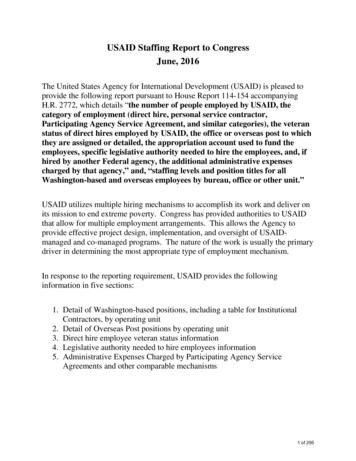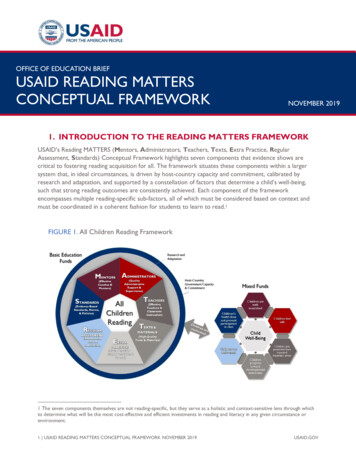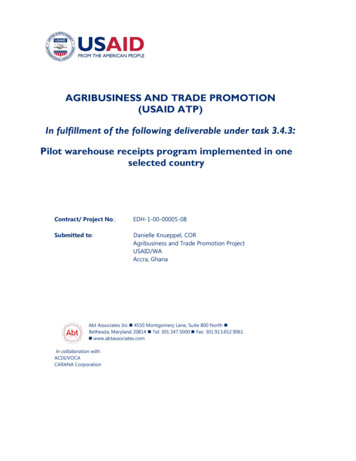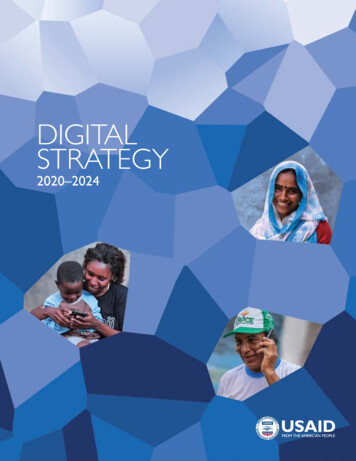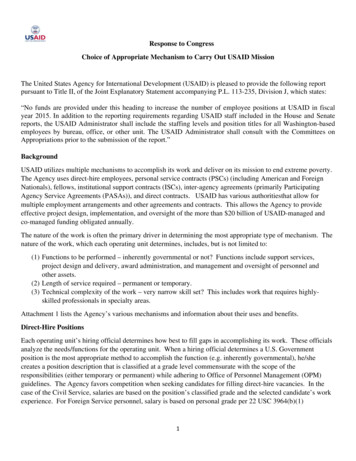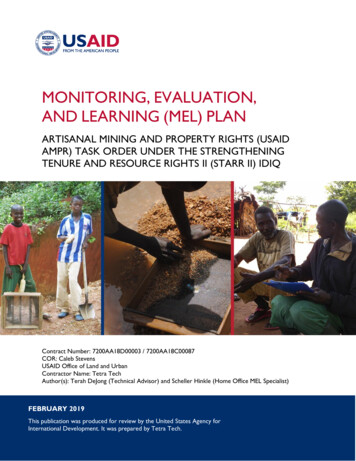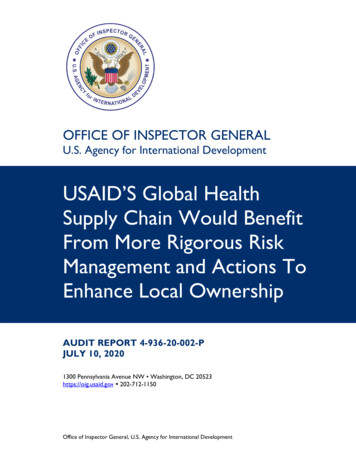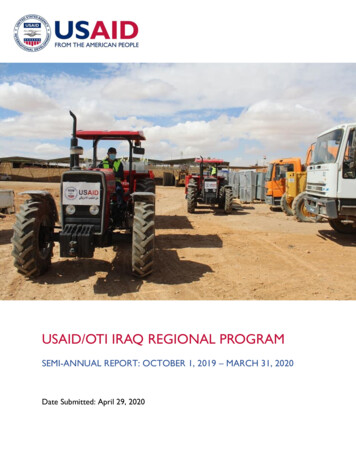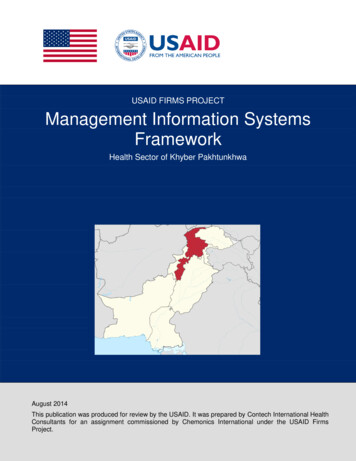
Transcription
USAID FIRMS PROJECTManagement Information SystemsFrameworkHealth Sector of Khyber PakhtunkhwaAugust 2014This publication was produced for review by the USAID. It was prepared by Contech International HealthConsultants for an assignment commissioned by Chemonics International under the USAID FirmsProject.
USAID FIRMS PROJECTManagement Information SystemsFrameworkHealth Sector of Khyber PakhtunkhwaDISCLAIMERThe author’s views expressed in this publication do not necessarily reflect the views of the United States Agency forInternational Development, the United States Government or Chemonics International Inc.
Data PageContract Number:GBTI II Task Order No. EEM-4-07-07-00008-00Contractor Name:Chemonics International, Inc.Name of the Component:USAID FIRMS ProjectUSAID Technical Office:Office of the Economic Growth and Agriculture;USAID PakistanDate of Report:August 2014Document Title:Management Information Systems FrameworkAuthor’s Name:Contech International Health ConsultantsStudy Design and Methodology:Contech International Health ConsultantsUSAID Firms ProjectPage. i
USAID Firms ProjectPage. ii
AcronymsCPSPCollege of Physicians and Surgeons PakistanDEWSDisease Early Warning SystemDGHSDirector General Health ServicesDHDCDistrict Health Development CenterDHISDistrict Health Information SystemDOHDepartment of HealthEDOHExecutive District Officer HealthHISHealth Information SystemsHRHuman ResourceIDSIntegrated Development StrategyHSRUHealth Sector Reforms UnitITInformation TechnologyKPKhyber PakhtunkhwaKMUKnowledge Management UnitMDGsMillennium Development GoalsMISManagement Information SystemsM&EMonitoring and EvaluationNCDsNon-Communicable DiseasesPHSAProvincial Health Services AcademyPHDCProvincial Health Development CentrePIUProject Implementation UnitPMDCPakistan Medical and Dental CouncilP&DPlanning and DevelopmentUCUnion CouncilWHOWorld Health OrganizationUSAID Firms ProjectPage. iii
USAID Firms ProjectPage. iv
Table of Contents1.2.CONTEXT. 11.1BACKGROUND . 11.2CHALLENGES IN HEALTH INFORMATION SYSTEMS . 1MANAGEMENT INFORMATION SYSTEMS FRAMEWORK . 32.1DATA REPOSITORY . 32.1.1.1INSTITUTION-BASED SOURCES . 42.1.1.2POPULATION-BASED SOURCES . 52.2KNOWLEDGEMENT MANAGEMENT UNIT. 52.2.1 DATA PROCESSING COMPONENT . 52.2.2 DATA DISSEMINATION COMPONENT . 63.2.3COORDINATION MECHANISMS . 72.4USERS OF THE DATA OUTPUTS . 72.5IMPLEMENTATION STRATEGY . 72.6INSTITUTIONALIZATION AND SUSTAINABILITY . 8REFERENCES . 9USAID Firms ProjectPage. v
USAID Firms ProjectPage. vi
MIS Framework – Health Sector of Khyber Paktunkhwa1.Final ReportContext1.1 BackgroundHealth outcomes of KP’s population are reflective of a highly inadequate healthcare deliverysystem. Overall, the health status of the provincial population and the management of theprovision of health services have failed to register any significant improvement over the manyyears since the adoption of the MDGs. The state provision of health services fares poorly interms of its efficiency, effectiveness and the extent of the coverage of the poor population.People living in remote areas cannot access health services due to the non-availability of suchservices near their localities. Poverty increases with disease and illness, as incomeopportunities are lost. Government has realigned development priorities to provide socialservices, with health and education as top priorities, and further aims to address deficiencies inthe healthcare system, improve management at the facility and supervisory levels through amulti-dimensional but integrated approach.Pursuit of these health goals involves decisions to optimize available resources, attend topriority issues and deploy strengths to counter emergencies. Without reliable informationoptimal deployment of resources and adoption of appropriate solution does not take place orlags far behind. Information is essential to chart out the broader health environment in whichhealth system in KP operates. It is also necessary to gauge the performance of the system itselffrom time to time and look for timely policy responses and management actions. Soundmanagement geared toward delivery of specific health goals is not possible on the basis ofcredible information on health challenges, on the environment in which the health systems workand on various performance indicators to characterize the working of the health system.11.2Challenges in Health Information SystemsHealth information systems (HIS) play an important role in ensuring that reliable and timelyhealth information is available for operational and strategic decision-making. HIS is acrosscutting component, providing the basis for the overall policy and regulation of all the otherhealth system blocks. It is essential for health system policy development and implementation,governance and regulation, health research, human resources development, health educationand training, service delivery and financing. HIS is sometimes equated with monitoring andevaluation but this is too reductionist a perspective. In addition to being essential for monitoringand evaluation, the information system also serves broader objectives, such as providing analert and early warning capability, supporting patient and health facility management, enablingplanning, underpinning and stimulating research, permitting health situation and trendsanalyses, orienting global reporting, and reinforcing communication of health challenges todiverse users. Information is of little value if it is not available in formats that meet the needs ofmultiple users, i.e. policymakers, planners, managers, healthcare providers, communities andindividuals.Availability of credible data is essential to chart out the burden of disease, the efficacy of variouspolicy interventions and the mundane working of healthcare in the province. The current state ofhealth data is very weak. It is an area of management that has been long ignored. Decisionmaking seldom requires evidence from the field. In the absence of such demands from decisionmaking levels in government, data systems have not developed to produce timely, accurate andcredible data. Only periodic surveys provide insights into health indicators. Despite of the
MIS Framework – Health Sector of Khyber PaktunkhwaFinal Reportendeavours, data collection, processing, analysis, transmitting and presenting the informationhas always remained a challenge to date, as identified in the challenges to be addressed inorder to strengthen the health information system2 are as follows: Overall information system in the province is fragmented as existing systems for facilitybased and community based information suffer lack of integration at district level. Therefore,planning process aiming at informed decision-making remain without this importantcomponent of analysis. There is no standardized and regular reporting mechanism for tertiary hospitals. Similarly,current HIS does not cover private sector hospitals and healthcare facilities, which deliverhealthcare services to a larger proportion of population in KP. There is no integrated disease surveillance system in the province, which is owned andimplemented by the DoH or DGHS. WHO introduced Disease Early Warning System(DEWS) has limited implementation and poor integration in public health facilities. Again,there is no inclusion of private sector for establishing an extensive disease surveillancemechanism in the province. Despite a number of surveys and research studied conducted every year by differentagencies, there is no mechanism for central storage of data at the provincial level. There is no mechanism available for public dissemination of performance of health sectorbased on information collected through health information system. Health related research in the province is still not catering to the research and informationneeds of the province. Research infrastructure in the province is poorly developed due tolack of expertise, resources and incentives.All the issues that come across in managing the health information, needs to be resolved toensure the evidence based decision-making that is transparent, for the benefit of the population.Healthcare system must be designed, based on strategies and intervention to understand theavailable information, technological options and their application to justify the reason for thechange in the existing practice. There is a need to devise and formulate mechanisms, which arein place for timely data collection, analysis and dissemination of the information. That iscontinuously monitored and evaluated at all the levels of the data flow; input, processes, outputsand outcomes to improve timely dissemination and communication of the quality data,advocating the performance of the health system, to all the major and minor stakeholders.
MIS Framework – Health Sector of Khyber Paktunkhwa2.Final ReportManagement InformationSystems FrameworkThis rationale signifies the lack of one unified source of information about the health relatedinformation. Hence, there is dire need for a system to be emplaced for tackling the healthinformation collection and usage challenges. It is one of the strategic priorities of the GoKP, asaccording to the IDS 2014-2018, one of the key strategic measures targeting the evidencebased decision-making is to “Establish a Knowledge Management Unit at PHSA linked withKhyber Medical University”.3This framework will fill this gap and allow easier access to knowledge in a move towardscreating a culture of research and evidence based decision making in the province. Keyobjectives of the frmaework includes the following.1. To identify all the health-related information and establish a central repository2. To provide a mechanism to capture, store, and integrate this information3. To develop its linkage with governmental departments operating the services (routine MIS),Bureau of Statistics, academic institutions, development partners and donors involved inhealth-related research4. To support the function of “clearing house” regarding health-related research5. To strengthen governance and assist policy makers, planners, and health managers inevidence-based decision-making2.1Data RepositoryIn KP, HIS draws upon a set of key data sources. The role and contribution of each sourcevaries due to overlap in the type of information best collected by each source. As shown infollowing figure, HIS data are usually generated either directly from populations or from theoperations of health and relevant institutions.
MIS Framework – Health Sector of Khyber PaktunkhwaFinal ReportFigure 1 Management Information Systems FrameworkSource of Data InputsKnowledge Management UnitData Processing ComponentData Dissemination ComponentOutcomesResponsiveness ofthe SystemInstitution-basedDataTimely Utilizationof ResourcesDashboardAlerts GenerationReportsAssessment of HealthSystem PerformancePopulationbased dataEvidance-BasedDecision makingPolicy BriefsEnhanced Quality& Equitable ServicesResearch DataIntegrated DataDepositoryTransparency& AccountabilityFigure 2 Sources of Data Inputs2.1.1.1 Institution-based sourcesInstitution-based sources generate data as a result of administrative and operational activities.Within the health sector of KP, the wide variety of health service data are produced throughroutine information systems, including morbidity and mortality data, for people using institutionbased health services; services delivered; drugs and commodities provided; information on theavailability and quality of services; case reporting; and resource, human, financial and logisticsinformation. Individual records including health records (for example, growth monitoring,antenatal, delivery outcome) and disease records (consultation, discharge) are important insupporting the quality and continuity of care for individual patients. Program based data
MIS Framework – Health Sector of Khyber PaktunkhwaFinal Reportcomprises of the existing vertical and other programs currently in place and supervised by theDepartment of Health4.Research data is an important constituent that may help establish link between evidence-basedknowledge and the existing policies to identify gaps that may be addressed and consideredwhile designing the M&E strategies. Coverage of data on institution-based services comes witha selection bias and therefore is of low value for analysing population trends.2.1.1.2Population-based sourcesPopulation-based sources generate data on all individuals within defined populations. In KP, itincludes total population counts such as the census and civil registration, and data onrepresentative populations or subpopulations such as household and other population surveys.Such data sources are either continuous and generated from administrative records such ascivil registers or periodic such as cross-sectional household surveys like Pakistan Demographicand Household Survey, Multiple Indicator Cluster Survey, and Pakistan Social and LivingStandards Measurement Survey.2.2Knowledgement Management UnitIn accordance with IDS 2014-2018, KP’s KMU shall be established within the realm of aProvincial Health Services Academy (PHSA) with linkages established with the Khyber MedicalUniversity. KMU will be implemented as an umbrella concept in PHSA and Khyber MedicalUniversity, and working collaboratively with HSRU, Director General Health Services (DGHS)and technical support of the development partners. The technical IT-support is required tochannel the bulk data influx from the source (input), through the data analysis unit, managed bythe work force to generate evidence-based information, which is to be disseminated to the endusers of the KMU. This will help build the organizational and technical capacity of the users (atprovincial, district and local level) of the KP KMU to generate quality data, for effectivemonitoring and evaluation to strengthen the process of decentralization. The termdecentralization is used in the context of the flow of feedback (information) from clients,community and community leaders, health managers to the decision/policy makers, thusincreasing the level of accountability within the system and achieving better health outcome.2.2.1 Data Processing ComponentKMU will gather all health related information from various input sources as its initialfundamental step synchronized with the framework. KMU’s team would analyze and convertavailable data inputs into evidence-based information that may aid in policy briefs, planningguides, disease and management alerts, M&E strategies and reports, strategic planning andcommissioning purposes. In a task-oriented work place, following three skill-mixes are requiredfor proposed framework of Data Processing Component of KMU. Analytical team comprising of Epidemiologists, Public Health Experts, Biostatisticians,Management Experts, and support staff Information validation team comprising of assessors Dissemination team comprising of Health Communication Experts and Graphic Designers
MIS Framework – Health Sector of Khyber PaktunkhwaFinal ReportIn the Data Processing Component, the data obtained from the input source is routed in acontinuous cycle of data processing and specific activities carried in order to generate evidencebased information are data validation & scrutiny; datafiltering, based on need and quality of the source.Integrated Data DepositoryAfter that, it is quantitatively and qualitativelyanalyzed for sharing with the stakeholders. Theprocessed information will then be used for the Data Managementprogram and task specific data integration in theIntegrated Data Depository by the team. At the end, Impact & Need-basedthe evidence-based information generated will ponent, in the form of dashboard interface, Strategic/Operational Planning &alerts generation, reports generation, M&E planningand reporting, advocacy of services, health systemManagementperformance evaluation, indicators mapping, needbased assessments, planning and commissioning of Establishing Coordination &services and promoting new research to strengthenConsultation with local &the healthcare system. Figure 1 represents theprocesses, working in accordance with one anotherProvincial Stakeholderscomprise the functional unit of the KP KMU, at thesame time linking the inputs with the outputs in the Policy & Decision Makingframework. Monitoring & Evaluation2.2.2 Data Dissemination ComponentInformation if collected but fail to reach theconcerned users is of no use. After data processing,key function of the KMU is dissemination of theinformation to the stakeholders and the users of theKP KMU. Information generated through analysis ofdata may be presented in different forms, which areas follows: Third Part Validation Use of Information for Strategy &Learning Development of Sustainable &Accountable Health System1. The integrated information may be presented asa dashboard for providing updated information toall the users on User Preferred Interface. This would include Input Mapped Updates (spotmapping), Diseases Trends and Prevalence, Rationalized Statistics (District, ProvincialDisease trends, and prevalence), Stakeholder Updates, and Downloadable Statistics.2. The alerts based on the standard guidelines may be generated through the data, to ensureeffective and efficient response of the healthcare services, thus providing a continuoussurveillance of the diseases, and forward and backward flow of information within thesystem. This will help in developing a continuous M&E system of the services and the alertresponse. Overall alerts generations (both immediate and scheduled) will cover Diseases(communicable, NCD, Notify-able early recognition), Cluster Marking (Disease Specific), andresource demands as well as availability.3. Report generation and the performance evaluation will be a click away, based on the users’compliance at the input phase and involvement in the framework of the model. Theimportance of the evidence-based information is that, the information collected will be therepresentation of the compliance of the system and may be compared with the outcomes
MIS Framework – Health Sector of Khyber PaktunkhwaFinal Reportindicators by all the users and the stakeholder, without the hassle of maintaining bulk blackand white paper documentation. Reports can be generated on Organizational Performance(Indicator specific), Rationalisation of Services, Duplication of Services, Financial(Accountability), Quality of Care, Access to the services, Services Mapping based onPopulation/Community Needs, Monitoring & Evaluation Reports, and Advocacy of theServices.4. Further, information would be generated regarding the Health System PerformanceEvaluation and provide data on indicators based on UC, District, and Provincial Data aboutPopulation Pyramids (Province-District-Tehsil-UC), Disease Trends of the Districts (Incomparison to National & Provincial Statistics), Financial Spending versus Allocations,Health System Performance Evaluation, and Effective Services Mapping & EquitableResource Mapping.2.3Coordination MechanismsData flow linkages will primarily be established with the health facilities working in the provinceof KP. Further, coordination mechanisms will be established with other provincial departments,organizations, development partners, international agencies, and regulatory bodies, nationaland international academic institutions working on health issues relevant to KP. Linkage withcomprehensive health research databases will be create by making a repository of all the openaccess and paid relevant literature and provide access to databases such as Pubmed,Cochrane Reviews, etc. This component should be available to individuals or institutions atsubsidized rates to encourage research in the province.2.4Users of the Data OutputsThis framework is designed to act as an information source that is continuously monitored andupdated based on the prevailing scenarios. An information reservoir that is free to access by thepeople to become aware of what the GoKP and Health Department is doing to overcome theprevailing health issues. This will create a transparent system that is self-advocated by thestrengthened health system. Apart from the KP, population, there are administrative institution,acting as the power/supportive users of the KP KMU, tasked with continuous feedback andevaluation of the service. These includes Planning & Development institution (P&D), FinancialInstitution, Department of Health (DoH), KP Health Sector Reform Unit (HSRU), DirectorGeneral Health Services (DGHS), Provincial Health Development Centre (PHDC) & DistrictHealth Development Centre (DHDC), Vertical Programs, District Health Management Teams(DHMT), Donor and Development Partners, Health Institutions (PMDC, CPSP), Private andNon-Government Institutions.2.5Implementation StrategyInitially USAID FIRMS will provide technical support to the DoH, GoKP in designing of theframework to sustainably manage and take ownership of MIS Framework. In order to sustainfunctional integration, the framework is divided into two implementation units at District andProvincial level. Provincial implementation plan consists of developing a Programimplementation Unit (PIU). In the District an experienced District Resource Person (DRP),based in the DHIS cell located at the EDOH office will assist in the implementation of the KPKMU. This district and provincial implementation strategy will be according to the work forceplacement in PHSA, linked with Khyber Medical University.
MIS Framework – Health Sector of Khyber PaktunkhwaFinal ReportUtilizing the existing DHIS human resource/health facility staff for the health facility data(Service and Resource record) with additional HR support, Information will continue to flow fromall health facilities in the KP, DHIS cells in districts and DGHS office, to the PIU; PIU willmanage the overall program. DHIS cell will coordinate with the health facilities in the districts.Additional support will be district specific consisting of the District Resource Person (DRP) (1per district) stationed at the DHIS cell in the EDOH office. Provincial PIU will provide IT technicalsupport at the Provincial level within the PIU. It will assist in placement of IT equipment (Dataservers, Backup servers, IT team to manage the information with the technical support from thework force) to provide Dashboard User Interface, Active Disease Surveillance, and InformationDissemination and Alerts generation.At the District level technical support will be provided through fixed work stations (whererequired based on already existing DHIS system), and provision of Android Handsets for healthfacility based staff (with software app to update live data and information).2.6Institutionalization and SustainabilitySustainability of this framework is a significant concern as a number of health programs havefailed to last in KP and rest of the provinces of Pakistan during recent years. The proposedframework for MIS addresses these concerns of health leaders, including policy makers,planners, funders, and manager for improving sustainability by taking a systems approach. Thisapproach reflects a focus on three areas: program institutionalization, capacity building, andmaintenance of health benefits5.Institutionalization involves the incorporation of the programs into existing organization andcommunity structure and it is concerned to ensure that program activities (rather thanoutcomes) are sustained over time. In order to institutionalize this framework, it will beestablished in an existing public sector infrastructure – Provincial Health Services Academy. Itslinkages with Khyber Medical University will also provide a platform for technical supervision.Another aspect of sustainability is concerns about system or organization’s capacity to provideinfrastructure, workforce, facilities and equipment, and to be innovative and respond toemerging needs through research and monitoring6. In the proposed framework, operations ofKMU will be funded through routine public health care expenditures of GoKP. Initial cost ofsetting up physical infrastructure, IT component, and facility level capacity building can beobtained through donors and development partners but they will not be relied upon for recurrentexpenditures.Purpose of all health programs is to produce health benefits. Therefore, in order to sustain theMIS Framework, it will have to produce sufficient health benefits while keeping in view the costof resources. It is expected that the performance of KMU will improve the technical efficiency ofprovincial health department that will translate into health benefits outnumbering the cost ofKMU.
MIS Framework – Health Sector of Khyber Paktunkhwa3.Final ReportReferences1Government of Khyber Pakhtunkhwa. Integrated Development Strategy 2014-2018.2Government of Khyber Pakhtunkhwa, Department of Health. Health Sector Situation Analysisfor Health Sector Strategy, 2010.3Government of Khyber Pakhtunkhwa. Integrated Development Strategy 2014-2018.4Government of Pakistan and Government of Japan. Improvement of Management InformationSystems in Health Sector in the Islamic Republic of Pakistan, 2006.5Scheirer MA. Is Sustainability Possible? A Review and Commentary on Empirical Studies ofProgram Sustainability. American Journal of Evaluation. 2005 September 1, 2005;26(3):320-47.6Swerissen H, Crisp BR. The sustainability of health promotion interventions for different levelsof social organization. Health Promotion International. 2004;19 (1):123-30.
USAID Firms Projectinfo@epfirms.com
Management Information Systems Framework Health Sector of Khyber Pakhtunkhwa August 2014 This publication was produced for review by the USAID. It was prepared by Contech International Health Consultants for an assignment commissioned by Chemonics International under the USAID Firms Project.

